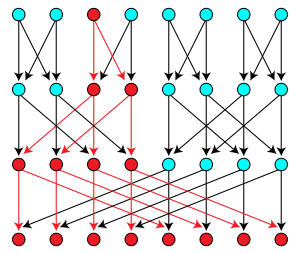Multitree

In combinatorics and order-theoretic mathematics, a multitree may describe either of two equivalent structures: a directed acyclic graph in which the set of nodes reachable from any node form a tree, or a partially ordered set that does not have four items a, b, c, and d forming a diamond suborder with a ≤ b ≤ d and a ≤ c ≤ d but with b and c incomparable to each other (also called a diamond-free poset[1]).
Equivalence between directed acyclic graph and poset definitions
If G is a directed acyclic graph ("DAG") in which the nodes reachable from each vertex form a tree (or equivalently, if G is a directed graph in which there is at most one directed path between any two nodes, in either direction) then the reachability relation in G forms a diamond-free partial order. Conversely, if P is a diamond-free partial order, its transitive reduction forms a DAG in which the successors of any node form a tree.
Diamond-free families
A diamond-free family of sets is a family F of sets whose inclusion ordering forms a diamond-free poset. If D(n) denotes the largest possible diamond-free family of subsets of an n-element set, then it is known that
and it is conjectured that the limit is 2.[1]
Applications
Multitrees may be used to represent multiple overlapping taxonomies over the same ground set.[2] If a family tree may contain multiple marriages from one family to another, but does not contain marriages between any two blood relatives, then it forms a multitree.[3] In the context of computational complexity theory, multitrees have also been called strongly unambiguous graphs or mangroves; they can be used to model nondeterministic algorithms in which there is at most one computational path connecting any two states.[4]
Related structures
A polytree, a directed acyclic graph formed by assigning an orientation to each edge of an undirected tree, may be viewed as a special case of a multitree.
The set of all nodes connected to any node u in a multitree forms an arborescence.
The word "multitree" has also been used to refer to a series-parallel partial order,[5] or to other structures formed by combining multiple trees.
References
- 1 2 Griggs, Jerrold R.; Li, Wei-Tian; Lu, Linyuan (2010), Diamond-free families, arXiv:1010.5311
 .
. - ↑ Furnas, George W.; Zacks, Jeff (1994), "Multitrees: enriching and reusing hierarchical structure", Proc. SIGCHI conference on Human Factors in Computing Systems (CHI '94), pp. 330–336, doi:10.1145/191666.191778.
- ↑ McGuffin, Michael J.; Balakrishnan, Ravin (2005), "Interactive visualization of genealogical graphs", IEEE Symposium on Information Visualization, Los Alamitos, CA, USA: IEEE Computer Society, pp. 3–3, doi:10.1109/INFOVIS.2005.22.
- ↑ Allender, Eric; Lange, Klaus-Jörn (1996), "StUSPACE(log n) ⊆ DSPACE(log2 n/log log n)", Algorithms and Computation, 7th International Symposium, ISAAC '96, Osaka, Japan, December 16–18, 1996, Proceedings, Lecture Notes in Computer Science, 1178, Springer-Verlag, pp. 193–202, doi:10.1007/BFb0009495.
- ↑ Jung, H. A. (1978), "On a class of posets and the corresponding comparability graphs", Journal of Combinatorial Theory, Series B, 24 (2): 125–133, doi:10.1016/0095-8956(78)90013-8, MR 0491356.